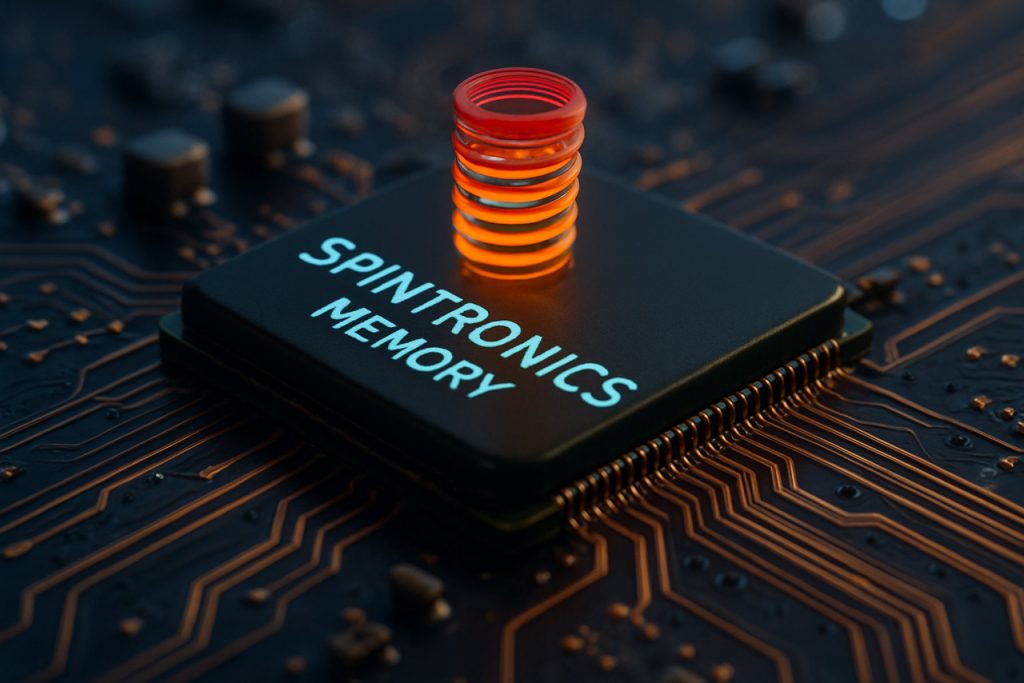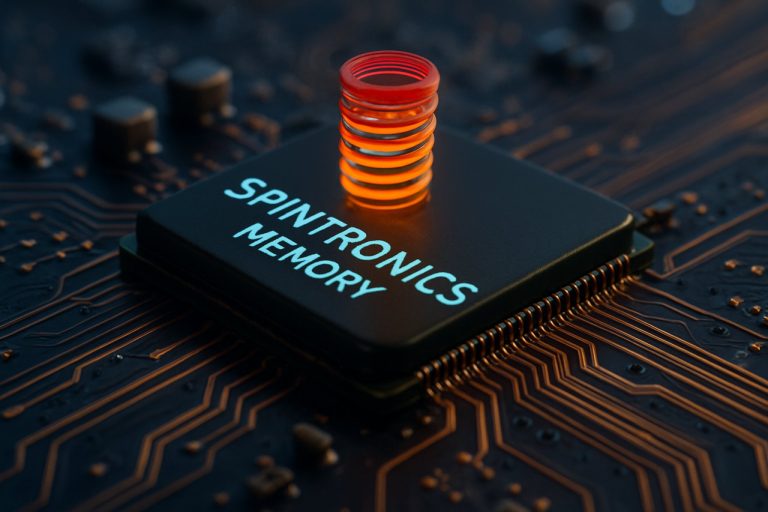
Spintronics-Based Memory Devices in 2025: Unleashing the Next Generation of High-Speed, Low-Power Data Storage. Explore How Spintronics is Transforming Memory Technology and Shaping the Future of Computing.
- Executive Summary: Key Trends and Market Outlook for 2025–2030
- Technology Overview: Principles and Types of Spintronics-Based Memory Devices
- Market Size and Growth Forecasts Through 2030
- Competitive Landscape: Leading Companies and Strategic Initiatives
- Recent Breakthroughs: Materials, Architectures, and Performance Enhancements
- Applications: From Data Centers to Edge Devices and IoT
- Challenges and Barriers: Scalability, Integration, and Cost Factors
- Regulatory and Standards Landscape: Industry Guidelines and Compliance
- Investment, M&A, and Partnership Activity in Spintronics Memory
- Future Outlook: Emerging Opportunities and Long-Term Impact on the Memory Industry
- Sources & References
Executive Summary: Key Trends and Market Outlook for 2025–2030
Spintronics-based memory devices, particularly Magnetoresistive Random Access Memory (MRAM), are poised for significant growth and technological advancement between 2025 and 2030. The sector is driven by the need for faster, more energy-efficient, and non-volatile memory solutions in data centers, automotive electronics, and edge computing. MRAM, leveraging electron spin rather than charge, offers advantages such as high endurance, low power consumption, and scalability, making it a strong candidate to supplement or replace traditional memory technologies like SRAM and DRAM.
In 2025, leading semiconductor manufacturers are accelerating the commercialization of spintronics-based memory. Samsung Electronics and Taiwan Semiconductor Manufacturing Company (TSMC) have both announced investments in embedded MRAM (eMRAM) for advanced process nodes, targeting applications in AI accelerators and IoT devices. GlobalFoundries is actively offering eMRAM as a foundry service, with volume production underway for automotive and industrial customers. Infineon Technologies and STMicroelectronics are also developing MRAM solutions for microcontrollers and secure elements, aiming to enhance reliability and data retention in harsh environments.
Recent data from industry consortia and company disclosures indicate that MRAM bit densities are expected to surpass 1 Gb by 2025, with sub-20nm process integration becoming feasible. This progress is supported by advances in perpendicular magnetic tunnel junctions (pMTJ) and spin-orbit torque (SOT) switching mechanisms, which improve write speed and reduce power consumption. The automotive sector, in particular, is adopting MRAM for its resilience to radiation and extreme temperatures, with Tier 1 suppliers integrating MRAM into next-generation electronic control units.
Looking ahead to 2030, the outlook for spintronics-based memory devices is robust. Industry roadmaps suggest that MRAM will increasingly penetrate markets currently dominated by NOR flash and SRAM, especially in edge AI, wearables, and industrial automation. The emergence of new spintronic phenomena, such as voltage-controlled magnetic anisotropy (VCMA), is expected to further enhance device performance and scalability. Strategic partnerships between foundries, fabless chip designers, and materials suppliers will be critical in overcoming remaining challenges related to cost, yield, and integration with logic processes.
In summary, the period from 2025 to 2030 will likely see spintronics-based memory devices transition from niche applications to mainstream adoption, driven by the combined efforts of major semiconductor manufacturers and the growing demand for high-performance, energy-efficient memory in a data-centric world.
Technology Overview: Principles and Types of Spintronics-Based Memory Devices
Spintronics-based memory devices leverage the intrinsic spin of electrons, in addition to their charge, to store and manipulate information. This duality enables non-volatile, high-speed, and energy-efficient memory solutions, distinguishing spintronics from conventional charge-based electronics. The core principle involves controlling the magnetic state of materials—typically thin ferromagnetic layers—using spin-polarized currents or magnetic fields, which represent binary data.
The most commercially advanced spintronics memory technology is Magnetoresistive Random Access Memory (MRAM). MRAM stores data by altering the relative orientation of two ferromagnetic layers separated by a thin insulating barrier, forming a magnetic tunnel junction (MTJ). The resistance of the MTJ changes depending on whether the magnetic layers are aligned parallel or antiparallel, corresponding to logical “0” or “1”. Two main MRAM variants are prevalent: Spin-Transfer Torque MRAM (STT-MRAM) and Spin-Orbit Torque MRAM (SOT-MRAM). STT-MRAM uses spin-polarized currents to switch the magnetic state, while SOT-MRAM employs spin-orbit effects for faster and more energy-efficient switching.
As of 2025, leading semiconductor manufacturers are actively developing and scaling MRAM technologies. Samsung Electronics has integrated embedded MRAM (eMRAM) into its 28nm process node, targeting applications in IoT, automotive, and AI edge devices. Taiwan Semiconductor Manufacturing Company (TSMC) is collaborating with partners to offer MRAM as an embedded non-volatile memory option in advanced CMOS nodes, aiming for high endurance and low power consumption. GlobalFoundries has also announced volume production of eMRAM on its 22FDX platform, emphasizing its suitability for low-power, high-performance applications.
Beyond MRAM, other spintronics-based memory concepts are under active research. Racetrack memory, pioneered by IBM, utilizes the movement of magnetic domain walls along nanowires to store data, promising ultra-high density and endurance. While racetrack memory remains in the experimental stage, advances in materials and nanofabrication are expected to accelerate its development in the coming years.
The outlook for spintronics-based memory devices in 2025 and beyond is promising. Industry roadmaps indicate increasing adoption of MRAM in embedded and standalone memory markets, driven by its scalability, speed, and non-volatility. Ongoing research into new materials, such as antiferromagnets and topological insulators, may further enhance device performance and enable novel architectures. As fabrication processes mature and costs decrease, spintronics-based memories are poised to play a pivotal role in next-generation computing, from edge devices to data centers.
Market Size and Growth Forecasts Through 2030
Spintronics-based memory devices, particularly magnetoresistive random-access memory (MRAM), are poised for significant market expansion through 2030, driven by their advantages in speed, endurance, and energy efficiency over conventional memory technologies. As of 2025, the global MRAM market is experiencing robust growth, with major semiconductor manufacturers scaling up production and integrating spintronic memory into a wider range of applications, from embedded systems to enterprise storage.
Key industry players such as Samsung Electronics, Taiwan Semiconductor Manufacturing Company (TSMC), and Intel Corporation are actively investing in spintronics R&D and manufacturing. Samsung Electronics has announced advancements in embedded MRAM (eMRAM) for system-on-chip (SoC) applications, targeting automotive, industrial, and AI edge devices. TSMC is collaborating with partners to integrate MRAM into advanced process nodes, aiming to offer foundry customers non-volatile memory options with high endurance and low power consumption. Intel Corporation continues to explore spintronic memory for next-generation computing architectures, with a focus on high-performance and data-centric workloads.
Specialized companies such as Everspin Technologies and Crocus Technology are also expanding their product portfolios. Everspin Technologies remains a leading supplier of discrete and embedded MRAM solutions, reporting increased shipments for industrial automation, aerospace, and data center applications. Crocus Technology is advancing tunnel magnetoresistance (TMR) sensor and memory technologies, targeting both memory and sensor markets.
Industry forecasts for 2025 and beyond indicate a compound annual growth rate (CAGR) in the double digits for spintronics-based memory, with the market expected to surpass several billion USD by 2030. Growth is fueled by the adoption of MRAM in automotive electronics, where reliability and endurance are critical, as well as in AI and IoT devices that require fast, non-volatile memory. The transition from SRAM and NOR flash to MRAM in embedded applications is accelerating, supported by the scalability of spintronic devices to advanced semiconductor nodes.
Looking ahead, the spintronics-based memory market is set to benefit from continued investment by leading semiconductor manufacturers, increasing integration into mainstream products, and the emergence of new applications in edge computing and neuromorphic systems. As manufacturing yields improve and costs decrease, spintronic memory is expected to capture a growing share of the non-volatile memory market through 2030.
Competitive Landscape: Leading Companies and Strategic Initiatives
The competitive landscape for spintronics-based memory devices in 2025 is characterized by a dynamic interplay among established semiconductor giants, specialized memory manufacturers, and emerging technology firms. The primary focus is on the commercialization and scaling of magnetoresistive random-access memory (MRAM) and its variants, such as spin-transfer torque MRAM (STT-MRAM) and spin-orbit torque MRAM (SOT-MRAM), which promise non-volatility, high endurance, and fast switching speeds.
Among the leading players, Samsung Electronics continues to assert its dominance, leveraging its advanced foundry capabilities and deep expertise in memory technologies. In recent years, Samsung has announced the mass production of embedded MRAM (eMRAM) for system-on-chip (SoC) applications, targeting automotive, industrial, and AI edge devices. The company’s roadmap includes further scaling of MRAM densities and integration with advanced process nodes, aiming to address both standalone and embedded markets.
Taiwan Semiconductor Manufacturing Company (TSMC) is another pivotal player, offering MRAM as an embedded non-volatile memory option in its 22nm and 28nm process technologies. TSMC’s foundry services enable fabless design houses to incorporate MRAM into a wide range of applications, from IoT to automotive electronics, and the company is expected to expand MRAM offerings to more advanced nodes in the coming years.
GlobalFoundries has also made significant strides, with its 22FDX platform supporting eMRAM for low-power, high-performance applications. The company has highlighted partnerships with automotive and industrial customers, and its roadmap includes further enhancements in MRAM performance and reliability.
In the United States, Micron Technology and Western Digital are actively exploring spintronics-based memory, with research and pilot production lines focused on next-generation MRAM and related technologies. While these companies have not yet announced large-scale commercial MRAM products, their ongoing investments signal a commitment to entering the market as the technology matures.
Startups and specialized firms such as Everspin Technologies play a crucial role in the ecosystem. Everspin remains the only company with volume production of discrete MRAM products, supplying both toggle and STT-MRAM to industrial, automotive, and enterprise storage markets. The company’s strategic partnerships with foundries and system integrators position it as a key enabler for broader MRAM adoption.
Looking ahead, the competitive landscape is expected to intensify as more companies achieve technical milestones and scale up production. Strategic initiatives include joint ventures, licensing agreements, and ecosystem collaborations to accelerate MRAM integration into mainstream computing and storage architectures. The next few years will likely see increased differentiation based on memory density, endurance, and compatibility with advanced semiconductor nodes, shaping the trajectory of spintronics-based memory commercialization.
Recent Breakthroughs: Materials, Architectures, and Performance Enhancements
Spintronics-based memory devices, particularly magnetoresistive random-access memory (MRAM), have witnessed significant breakthroughs in materials, device architectures, and performance metrics as of 2025. These advances are driven by the need for faster, more energy-efficient, and highly scalable non-volatile memory solutions for next-generation computing systems.
A major milestone in recent years has been the commercialization and scaling of spin-transfer torque MRAM (STT-MRAM) and the emergence of spin-orbit torque MRAM (SOT-MRAM). Leading semiconductor manufacturers such as Samsung Electronics and Taiwan Semiconductor Manufacturing Company (TSMC) have integrated STT-MRAM into embedded memory solutions for microcontrollers and system-on-chip (SoC) platforms. In 2024, Samsung Electronics announced the mass production of 1Gb STT-MRAM, demonstrating endurance exceeding 1012 cycles and sub-10ns write speeds, positioning MRAM as a viable replacement for SRAM and NOR flash in certain applications.
Material innovations have played a pivotal role in these advancements. The adoption of perpendicular magnetic anisotropy (PMA) in magnetic tunnel junctions (MTJs) has enabled higher density and lower switching currents. Companies such as TDK Corporation and Toshiba Corporation have reported progress in optimizing CoFeB/MgO-based MTJs, which are now standard in high-performance MRAM devices. Additionally, the exploration of novel materials like Heusler alloys and two-dimensional (2D) materials is ongoing, with the aim of further reducing power consumption and enhancing scalability.
Architectural breakthroughs include the development of SOT-MRAM, which separates the read and write current paths, thereby improving endurance and reliability. Intel Corporation and GLOBALFOUNDRIES have demonstrated SOT-MRAM prototypes with write speeds below 1ns and endurance suitable for cache memory applications. These architectures are expected to enter pilot production within the next few years, targeting high-performance computing and automotive sectors.
Looking ahead, the outlook for spintronics-based memory devices is robust. Industry roadmaps from IBM and Infineon Technologies AG indicate ongoing investment in scaling MRAM to sub-20nm nodes and integrating spintronic memory with logic circuits for in-memory computing. The convergence of advanced materials, innovative device architectures, and process integration is set to accelerate the adoption of spintronics-based memory in both embedded and stand-alone applications through 2025 and beyond.
Applications: From Data Centers to Edge Devices and IoT
Spintronics-based memory devices, particularly magnetoresistive random-access memory (MRAM), are rapidly transitioning from research labs to commercial deployment across a spectrum of applications, from large-scale data centers to edge devices and the Internet of Things (IoT). As of 2025, the industry is witnessing significant momentum, driven by the unique combination of non-volatility, high endurance, and fast switching speeds offered by spintronic memories.
In data centers, the demand for energy-efficient, high-performance memory is acute. MRAM’s ability to retain data without power and withstand billions of write cycles positions it as a promising candidate for replacing or complementing traditional SRAM and DRAM in cache and storage-class memory. Major semiconductor manufacturers such as Samsung Electronics and Taiwan Semiconductor Manufacturing Company (TSMC) have announced ongoing development and integration of embedded MRAM (eMRAM) into advanced process nodes, targeting high-speed, low-power applications in server and enterprise environments. Samsung Electronics has already demonstrated 1Gb MRAM chips and is collaborating with partners to scale up production for commercial deployment.
At the edge and in IoT devices, spintronics-based memories are gaining traction due to their low power consumption and instant-on capabilities. Companies like Infineon Technologies and NXP Semiconductors are actively developing MRAM solutions tailored for microcontrollers and automotive electronics, where reliability and endurance are critical. For example, NXP Semiconductors has introduced MRAM-equipped microcontrollers for automotive and industrial applications, enabling faster boot times and robust data retention in harsh environments.
In the IoT sector, the integration of MRAM is expected to accelerate as device manufacturers seek to extend battery life and enable secure, persistent data storage. Everspin Technologies, a pioneer in discrete MRAM products, continues to expand its portfolio, supplying both standalone and embedded MRAM solutions for industrial IoT, networking, and aerospace applications.
Looking ahead, the next few years are likely to see further scaling of MRAM densities, cost reductions through process improvements, and broader adoption in both high-performance computing and ultra-low-power edge devices. Industry collaborations and foundry support from leaders like GlobalFoundries are expected to accelerate the commercialization of spintronics-based memory, making it a foundational technology for the evolving landscape of data-centric applications.
Challenges and Barriers: Scalability, Integration, and Cost Factors
Spintronics-based memory devices, particularly magnetoresistive random-access memory (MRAM), are at the forefront of next-generation non-volatile memory technologies. However, their widespread adoption faces several challenges related to scalability, integration with existing semiconductor processes, and cost-effectiveness, especially as the industry moves into 2025 and the following years.
Scalability remains a significant barrier. As device dimensions shrink below 20 nm, maintaining reliable magnetic switching and thermal stability becomes increasingly difficult. The scaling of perpendicular magnetic tunnel junctions (pMTJs), a core component of MRAM, is limited by superparamagnetic effects and the need for high anisotropy materials. Leading manufacturers such as Samsung Electronics and Taiwan Semiconductor Manufacturing Company (TSMC) are actively researching advanced materials and stack engineering to address these issues, but mass production at sub-10 nm nodes is not yet fully realized.
Integration with complementary metal-oxide-semiconductor (CMOS) technology is another critical challenge. Spintronic devices require specialized fabrication steps, such as deposition of ultra-thin magnetic layers and precise patterning, which are not standard in conventional CMOS foundries. Companies like GlobalFoundries and Intel Corporation have demonstrated embedded MRAM (eMRAM) in advanced process nodes, but integrating these steps without impacting yield or reliability remains complex. Furthermore, the need for high-temperature annealing in CMOS processes can degrade the magnetic properties of spintronic layers, necessitating further process innovation.
Cost factors are a persistent concern. The materials used in spintronics, such as cobalt, platinum, and rare earth elements, are more expensive than those in traditional DRAM or flash memory. Additionally, the specialized equipment required for magnetic layer deposition and etching increases capital expenditure. While Micron Technology and Sony Corporation are investing in pilot lines and scaling up production, the cost per bit for MRAM remains higher than for established memory technologies. This cost gap is expected to narrow as yields improve and economies of scale are realized, but significant progress is still needed for MRAM to compete in high-volume markets.
Looking ahead, the industry outlook for 2025 and beyond suggests incremental progress. Collaborative efforts between memory manufacturers, foundries, and materials suppliers are accelerating innovation, but overcoming the intertwined challenges of scalability, integration, and cost will be essential for spintronics-based memory devices to achieve mainstream adoption in data centers, automotive, and edge computing applications.
Regulatory and Standards Landscape: Industry Guidelines and Compliance
The regulatory and standards landscape for spintronics-based memory devices is rapidly evolving as these technologies transition from research labs to commercial deployment. In 2025, the industry is witnessing increased activity from international standards organizations and industry consortia, aiming to ensure interoperability, safety, and reliability of emerging memory products such as Magnetoresistive Random Access Memory (MRAM) and related spintronic devices.
Key industry players, including Samsung Electronics, Taiwan Semiconductor Manufacturing Company (TSMC), and Infineon Technologies, are actively participating in the development of standards for spintronics-based memory. These companies are collaborating with global standards bodies such as the JEDEC Solid State Technology Association, which is responsible for memory device standards, and the Institute of Electrical and Electronics Engineers (IEEE), which oversees broader electronics and device interoperability standards.
In 2025, JEDEC continues to expand its focus on non-volatile memory (NVM) standards, with working groups addressing the unique requirements of MRAM and spintronic devices, including endurance, data retention, and interface protocols. The IEEE, through its Magnetics Society and various technical committees, is also advancing guidelines for spintronic device characterization, reliability testing, and integration with CMOS technologies. These efforts are crucial for ensuring that spintronics-based memory can be seamlessly adopted in mainstream computing and embedded applications.
Compliance with environmental and safety regulations is another area of emphasis. Companies such as Samsung Electronics and Infineon Technologies are aligning their manufacturing processes with the European Union’s RoHS (Restriction of Hazardous Substances) and REACH (Registration, Evaluation, Authorisation and Restriction of Chemicals) directives, as well as similar regulations in North America and Asia. This ensures that spintronic memory devices meet global requirements for hazardous material restrictions and environmental sustainability.
Looking ahead, the next few years are expected to bring further harmonization of standards, particularly as spintronics-based memory devices are integrated into automotive, industrial, and IoT applications. Industry consortia, such as the Semiconductor Industry Association (SIA), are advocating for unified global standards to facilitate cross-border trade and accelerate adoption. As the technology matures, regulatory frameworks will likely expand to address emerging concerns such as data security, device lifecycle management, and recycling of spintronic components.
Investment, M&A, and Partnership Activity in Spintronics Memory
The spintronics-based memory sector, particularly focused on magnetoresistive random-access memory (MRAM) and its variants, has seen a notable uptick in investment, mergers and acquisitions (M&A), and strategic partnerships as of 2025. This activity is driven by the growing demand for non-volatile, high-speed, and energy-efficient memory solutions in data centers, automotive electronics, and edge computing.
Major semiconductor manufacturers have continued to expand their spintronics memory portfolios through both organic investment and external collaborations. Samsung Electronics remains a global leader, having announced in late 2024 the expansion of its MRAM production lines to meet increasing demand from enterprise storage and automotive sectors. The company has also deepened its partnerships with automotive OEMs to integrate MRAM into advanced driver-assistance systems (ADAS) and autonomous vehicle platforms.
Similarly, Taiwan Semiconductor Manufacturing Company (TSMC) has invested in scaling its embedded MRAM (eMRAM) technology, targeting applications in microcontrollers and IoT devices. TSMC’s collaborations with leading fabless design houses have accelerated the commercialization of spintronics-based memory IP, with several new product launches anticipated through 2025 and 2026.
On the M&A front, Infineon Technologies completed the acquisition of a spintronics startup specializing in next-generation MRAM architectures in early 2025, aiming to bolster its automotive and industrial memory offerings. This move follows a broader trend of established players acquiring innovative startups to secure intellectual property and accelerate time-to-market for advanced memory solutions.
Strategic partnerships have also played a pivotal role. Applied Materials, a key supplier of semiconductor manufacturing equipment, has entered into joint development agreements with several memory manufacturers to optimize deposition and etching processes for spintronics materials. These collaborations are expected to improve yield and scalability, addressing one of the main challenges in MRAM mass production.
Looking ahead, the sector is poised for continued consolidation and cross-industry collaboration. As spintronics-based memory devices move from niche to mainstream adoption, especially in automotive and industrial automation, further investments and alliances are anticipated. The entry of new players, including foundries and materials suppliers, is likely to intensify competition and innovation, shaping the landscape of memory technology through the latter half of the decade.
Future Outlook: Emerging Opportunities and Long-Term Impact on the Memory Industry
Spintronics-based memory devices, particularly magnetoresistive random-access memory (MRAM), are poised to play a transformative role in the memory industry from 2025 onward. These devices leverage the electron’s spin, in addition to its charge, to store information, offering significant advantages in speed, endurance, and energy efficiency compared to conventional charge-based memories. As the demand for high-performance, non-volatile memory solutions accelerates—driven by applications in artificial intelligence, edge computing, automotive, and industrial IoT—spintronics-based technologies are gaining momentum in both research and commercialization.
In 2025, leading semiconductor manufacturers are scaling up production of MRAM and related spintronic memory products. Samsung Electronics has been at the forefront, integrating embedded MRAM (eMRAM) into its advanced process nodes for system-on-chip (SoC) applications, targeting low-power and high-speed requirements. Taiwan Semiconductor Manufacturing Company (TSMC) is also actively developing MRAM as an embedded non-volatile memory option for its customers, with pilot production lines and collaborations with IP providers. GlobalFoundries has announced volume production of eMRAM on its 22FDX platform, catering to automotive and industrial markets where reliability and endurance are critical.
On the materials and device innovation front, TDK Corporation and Applied Materials are investing in advanced magnetic materials and deposition technologies to improve the scalability and performance of spintronic devices. These efforts are crucial for overcoming challenges such as write current reduction, retention, and integration with CMOS processes. Meanwhile, startups like Everspin Technologies continue to expand discrete MRAM product lines, with densities now reaching gigabit-class, and are targeting enterprise storage, industrial automation, and aerospace sectors.
Looking ahead, the next few years are expected to see further breakthroughs in spin-orbit torque (SOT) MRAM and voltage-controlled MRAM, which promise even lower power consumption and faster switching speeds. Industry roadmaps suggest that spintronics-based memory could begin to replace or complement SRAM and NOR flash in certain embedded and cache applications, especially as process nodes shrink below 22nm. The long-term impact on the memory industry could be profound, with spintronics-based devices enabling instant-on systems, persistent caches, and new computing architectures that blur the line between memory and logic.
As ecosystem support grows and manufacturing yields improve, spintronics-based memory devices are set to capture a larger share of the non-volatile memory market, driving innovation across consumer electronics, automotive, and industrial sectors.
Sources & References
- Infineon Technologies
- STMicroelectronics
- IBM
- Everspin Technologies
- Crocus Technology
- Micron Technology
- Western Digital
- Toshiba Corporation
- NXP Semiconductors
- JEDEC Solid State Technology Association
- Institute of Electrical and Electronics Engineers (IEEE)
- Semiconductor Industry Association (SIA)



